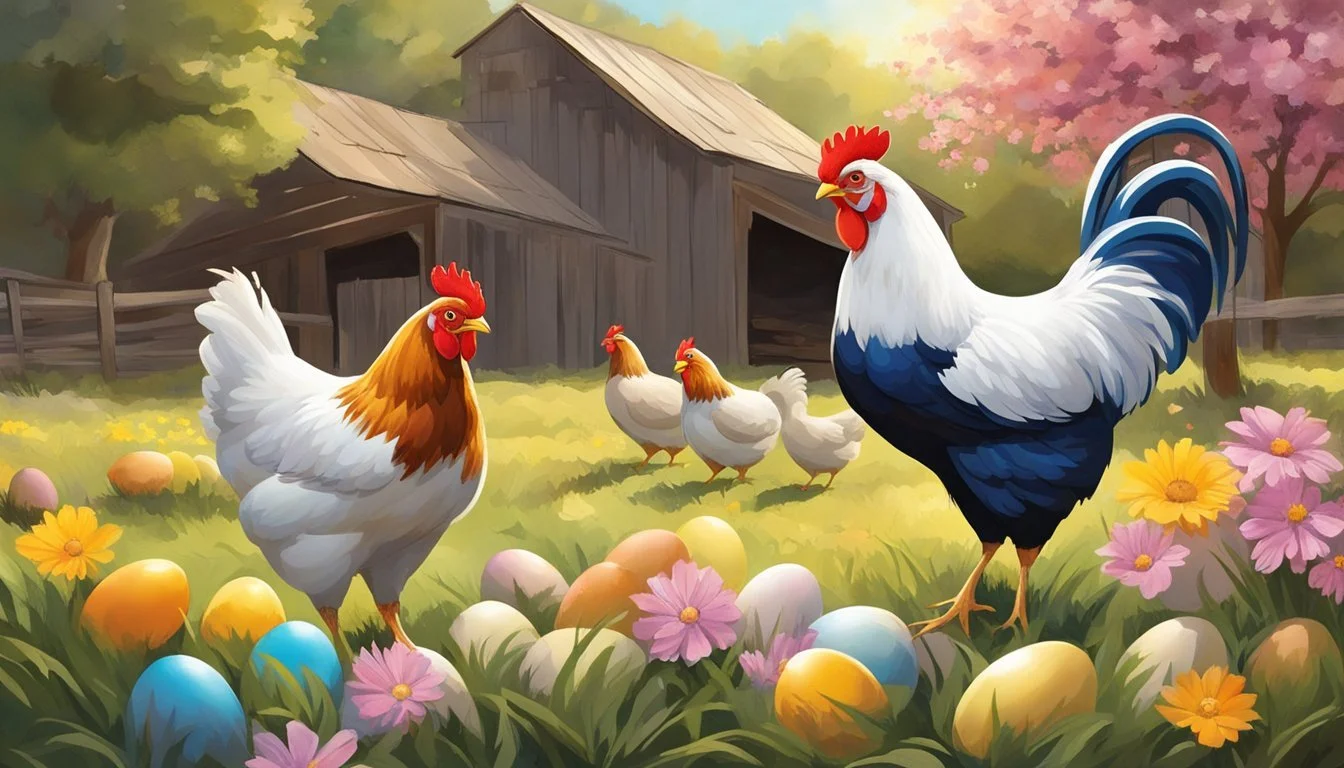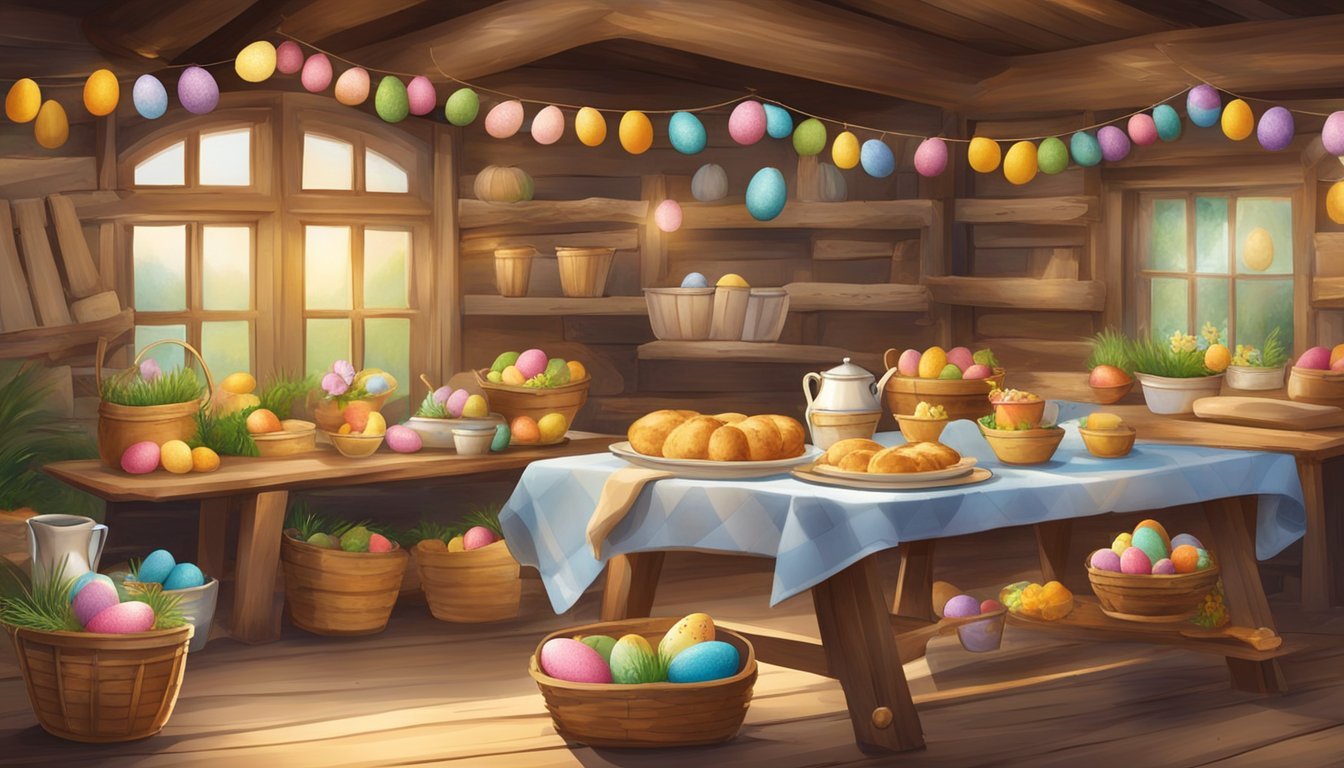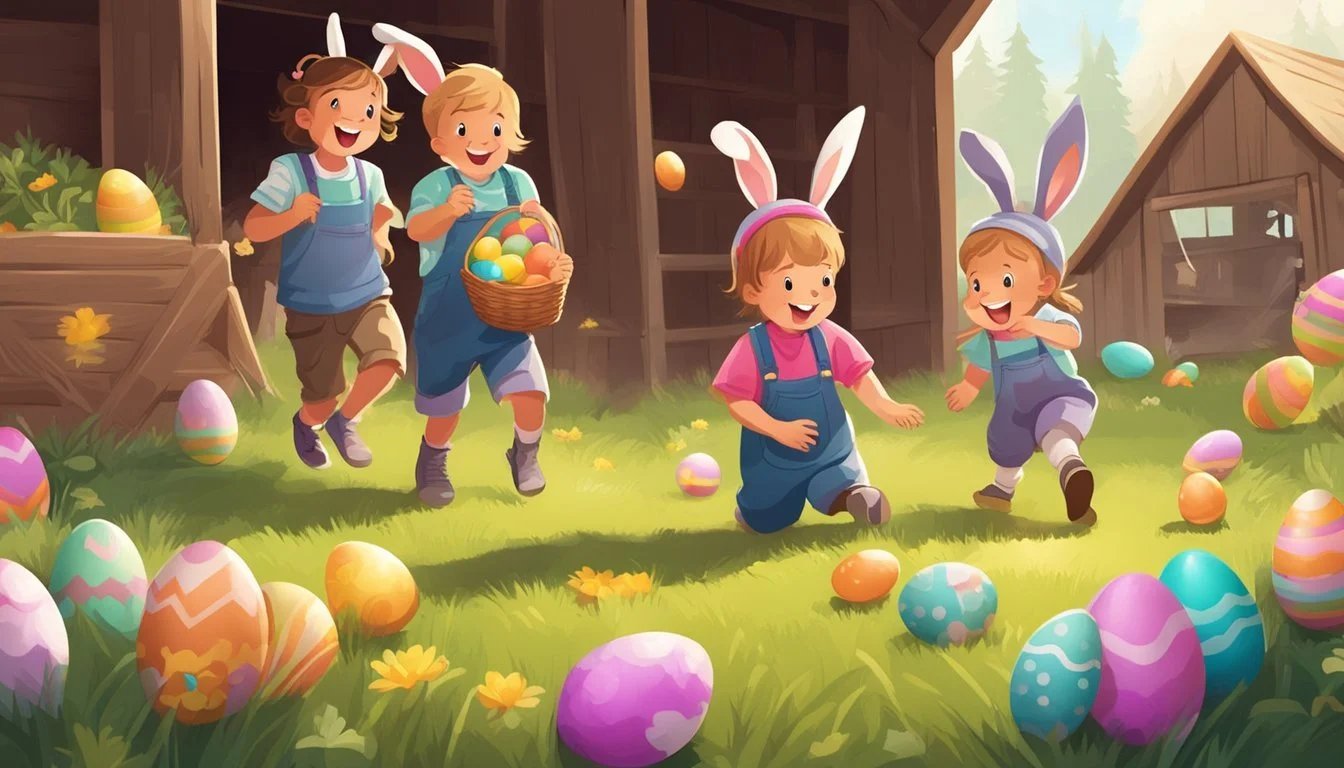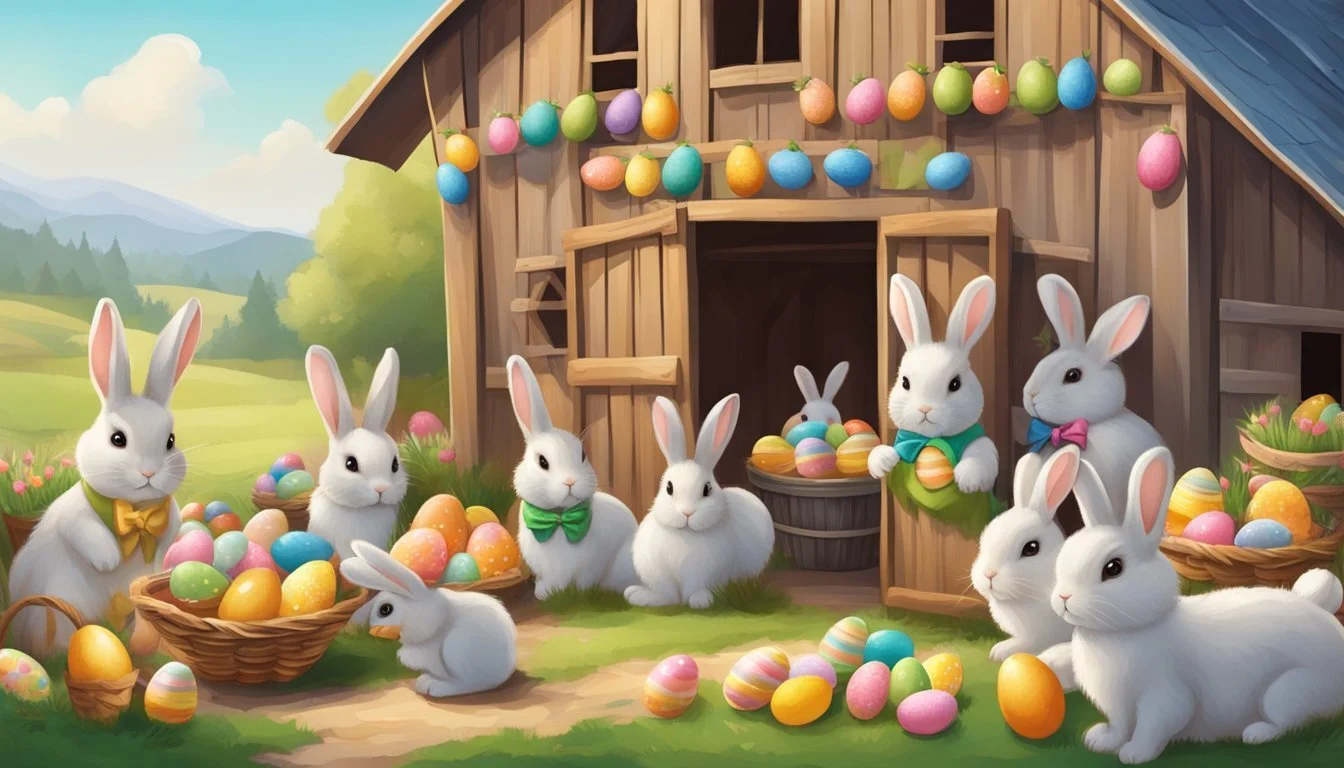Easter in the Barn
Celebrating Springtime with Farm-Fresh Festivities
Easter celebrations take on a unique charm when hosted within the rustic walls of a barn. This setting blends traditional holiday festivities with a touch of pastoral elegance, creating an atmosphere that captivates both adults and children alike. Across various locations, Easter in the barn presents a blend of activities, from lavish brunch (What wine goes well with brunch?) buffets to engaging family festivities, all underscored by the inviting backdrop of barnyard architecture and the warmth of a community gathering.
One hallmark of barn-centered Easter events is the incorporation of local traditions and seasonal decor. The Barn at Wight Farm, for instance, is known for its sumptuous Easter brunch, while down at Downey's Farm Market, Easter is marked by an array of activities such as face painting and wagon rides, celebrating the holiday with a festive flair. These events typically include thematic touches that reflect the spirit of Easter, with pastel shades and Easter motifs adorning the spaces.
Easter in the barn also emphasizes family-friendly experiences. Places like The Inn on Main and Greenville's family-owned shopping barn use their space to create a memorable holiday for all ages. From Easter egg hunts to the chance to meet farm animals or even a visit from the Easter Bunny, these venues provide an idyllic setting that allows guests to create lasting Easter memories against the unique backdrop of a barn environment.
History and Significance of Easter
The Easter holiday is a pivotal event in Christianity, commemorating the resurrection of Jesus Christ. This celebration is intertwined with various traditions and customs that have evolved over centuries.
Origins of Easter
The roots of Easter lie in the Christian belief that Jesus Christ was resurrected from the dead on the third day after his crucifixion. This event is seen as the foundation of the Christian faith, symbolizing victory over death and the hope of eternal life. Celebrated on the first Sunday following the first full moon after the vernal equinox, Easter's date varies each year.
Historical Evidence: Records indicate the observation of Easter as early as the second century, although the exact date for celebration would not be standardized until the First Council of Nicaea in 325 AD.
Easter Traditions and Customs
Lent: Preceding Easter is the 40-day period of Lent, marked by fasting and penance, drawing from the biblical narrative of Jesus fasting in the wilderness for 40 days.
Easter Eggs and the Easter Bunny:
Easter Eggs: These symbolize new life and resurrection. Decorated eggs are traditions that can be traced back to early Christians of Mesopotamia.
Easter Bunny: A figure believed to deliver candies and eggs, its origins may be connected to folklore about hares’ prolific breeding, symbolizing fertility and life.
Easter Services:
Numerous churches hold midnight vigils on Holy Saturday, leading to celebrations on Easter morning.
Sunrise services are also popular, commemorating the empty tomb discovered at dawn.
Celebrating Easter in a Rural Setting
In a rural setting, Easter embodies the essence of spring with outdoor activities and home decor that captures the season's vibrant and bright qualities.
Easter Activities in the Barn
Easter egg hunts: Families organize festive Easter egg hunts within the barn, using the haylofts and stalls as hiding spots. The spacious setting provides ample area for children to explore and find brightly colored eggs.
Petting zoos: Many barns introduce a seasonal petting zoo, featuring spring-born animals like lambs, chicks, and bunnies, offering a tactile and engaging experience for visitors.
Easter Decorations in a Farmhouse Style
Table Settings: Rustic elegance is achieved with farmhouse-style Easter table decor, integrating natural materials and pastel colors. The use of wooden accents, combined with fresh spring flowers, sets a welcoming scene.
Mantel Displays:
Fresh spring garlands
Vintage-inspired bunny figurines
Candles with subtle floral scents to evoke the freshness of spring
These decorations often feature reclaimed wood elements and distressed finishes to enhance the farmhouse aesthetic.
Easter Culinary Traditions
Easter celebrations are often marked by a rich array of foods, reflecting a blend of cultural and religious significance. From the symbolic use of eggs to the enjoyment of sweet and savory delights, Easter is a time when culinary traditions take center stage.
Typical Easter Foods
Ham: Often the centerpiece at Easter meals, it symbolizes joy and abundance. Various preparations include glazed ham, smoked varieties, and those studded with cloves.
Easter Basket: Traditionally filled with treats and eggs, these baskets represent the end of Lent and the return of richer foods to the diet.
Savory Dishes:
Easter bread: Braided and shaped into a wreath, often with hard-boiled eggs baked inside.
Pierogi: Eastern European potato-stuffed dumplings, central to many Easter feasts.
Sweet Treats:
Hot Cross Buns: Spiced buns marked with a cross, eaten on Good Friday in many cultures.
Pashka: A Russian cheese-filled dessert often enjoyed during Easter.
Tsoureki: A sweet, aromatic Greek Easter bread.
Baking and Cooking Activities
Baking:
Families may bake breads and desserts together, such as braided Easter breads that are beautifully embellished with dyed eggs.
Making hot cross buns, with their distinct spice flavor and symbolic decoration, is a common baking activity during the Easter period.
Cooking:
Preparing the Easter ham can be an elaborate process that includes glazing, baking, and often garnishing with pineapples or cherries.
Assembling an Easter basket with a variety of foods symbolizes both tradition and celebration, ranging from chocolate eggs to elaborately decorated cookies.
Creative Easter Crafts
Easter in the barn can become even more festive with engaging crafts that everyone can partake in. From painting eggs to weaving baskets, these activities not only add to the holiday spirit but also make for wonderful keepsakes.
Painting Easter Eggs
One of the quintessential Easter activities is painting Easter eggs. Whether using dye kits, acrylic paints, or natural dyes, individuals can showcase their creativity on the smooth surfaces of hard-boiled eggs or artificial ones. A variety of techniques can be employed, including applying different color layers, adding patterns with stencils, or using a sponge for a textured look. For a refined finish, a satin or grosgrain ribbon can be glued to create elegant hanging loops.
Handmade Easter Baskets
Handmade Easter baskets are as much a delightful craft as they are a personal touch to Easter festivities. They can be crafted from various materials like wicker, cardboard, or even woven fabric. For a DIY woven fabric basket:
Cut the base from matboard.
Weave together bright, festive fabrics.
Secure the fabric with a strong adhesive or sewing to ensure durability.
Embellish with ribbons and bows for a charming touch.
These baskets can be used to collect eggs during an Easter egg hunt or to display as a centerpiece filled with decorated eggs and other Easter treats.
Easter-Themed Art Projects
They can venture into wider Easter-themed art projects. These can range from 3D paper crafts, such as creating layered egg designs, to decorating paper plates turned into Easter characters or motifs. A popular activity is making floral wreaths with spring flowers, which can adorn the barn doors or walls. Another fun project is crafting table decorations and creating Easter-themed scenes with construction paper, fabric scraps, and natural elements like twigs and flowers.
Easter Games and Entertainment
Easter celebrations in the barn come alive with engaging activities that blend traditional elements with exciting games. The focus is on two main attractions: the quintessential Easter Egg Hunt and the intriguing Interactive Easter Puzzles, both designed to entertain participants of all ages while they enjoy the rustic charm of the barn setting.
Easter Egg Hunt
For many, the Easter Egg Hunt is the highlight of the celebration. Organizers can enhance the experience by incorporating different elements such as:
Themed Zones: Designate areas in the barn based on different Easter themes, like a corner with plush Easter bunny figures or a section with beautifully painted eggs.
Hidden Treasures: Along with the typical candy-filled eggs, include special eggs that contain clues leading to larger prizes, adding an extra layer of excitement.
Age-Specific Challenges: To ensure fairness and fun for all, create separate search areas or difficulty levels catered to different age groups.
Interactive Easter Puzzles
Interactive Easter Puzzles add a cerebral twist to the festive frolics. These can include:
Easter-themed Escape Rooms: Set up a corner of the barn as an escape room where teams must solve Easter-related puzzles to 'escape' within a certain time frame.
Puzzle Stations: Scatter various puzzle stations around the barn, each offering a unique challenge, such as an Easter bunny jigsaw or a word search with Easter terminology.
Utilizing these games and puzzles not only entertains but also fosters teamwork and a sense of accomplishment among participants.
Easter Treats and Confections
As families gather in barns adorned with springtime decor, the crafting of Easter treats and confections becomes a heartwarming focus. These creations not only indulge the palate but also evoke the joy and whimsy of the season's traditions.
Sweet Treats and Recipes
The transformation of simple ingredients into delightful Easter treats is a celebration of the season. Carrot Cake Muffins emerge as a fusion of classic carrot cake flavors with a rich, buttery streusel, reminiscent of coffee cake. Their handheld size makes them perfect for a barn gathering, subtly honoring the rustic charm of the setting.
Chocolate-Covered Eggs serve as the cornerstone of Easter confections. The versatility of chocolate allows for a myriad of fillings, from creamy centers to fruit-infused ganaches. Homemade versions of these eggs often surpass store-bought options, offering personalized flavors tailored to individual preferences.
For a crafty twist that captivates children and adults alike, one can create Marshmallow Bunnies, a seasonal take on a fluffy favorite. Rolling and shaping marshmallows dipped in pastel-colored sugars can turn the treat-making process into an interactive event within the barn.
Easter Bunny Delights
The iconic figure of the Easter Bunny brings a certain magic to Easter baskets filled with a colorful assortment of candies. M&M’s with their bright candy shells are a staple addition. Their miniature size and vast color range make them an attractive and versatile filler for plastic eggs or to sprinkle around the basket as a cheerful accent.
Easter baskets themselves become treasure troves brimming with confections. They embody the spirit of Easter as they hold an assortment of sweets, carefully curated to delight recipients of all ages. The presentation of an Easter basket, often adorned with ribbons and festive lining, adds to the overall enchantment of the holiday's confections.
Eco-Friendly Easter Celebrations
Eco-friendly Easter celebrations are possible by incorporating sustainable practices and natural decoration ideas into traditional festivities.
Sustainability and Easter
Easter celebrations can have a significant impact on the environment. To mitigate this, individuals are encouraged to choose ethical, low-waste candy options and to incorporate reusable or biodegradable materials wherever possible. For instance, using natural Easter egg dyes made from food scraps like beets or red cabbage reduces dependency on artificial colorings and emphasizes a return to traditional methods.
One can embrace the outdoors, where Easter egg hunts can be held, by minimizing the environmental footprint. Biodegradable materials like real grass instead of plastic grass fillers for Easter baskets are a simple yet effective swap that ensures festivities do not harm the natural settings they take place in.
Natural Decoration Ideas
Natural decoration ideas for Easter are both sustainable and visually appealing. Here are specific ways to celebrate while respecting nature:
Natural Egg Dyes: Utilize vegetables, fruits, and spices to create a palette of safe, eco-friendly dyes for Easter eggs.
Organic Basket Fillers: Replace synthetic materials with organic alternatives such as:
Soil and wheatgrass seeds
Moss or leaves gathered from outdoors
Shredded paper or newspaper
By opting for decorations that are in harmony with the environment, Easter can be a celebration that is not only fun but also respects the planet.






